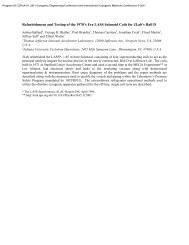CEC Abstracts in PDF format (as of 7/3/07) - CEC-ICMC 2013
CEC Abstracts in PDF format (as of 7/3/07) - CEC-ICMC 2013
CEC Abstracts in PDF format (as of 7/3/07) - CEC-ICMC 2013
Create successful ePaper yourself
Turn your PDF publications into a flip-book with our unique Google optimized e-Paper software.
<strong>CEC</strong> 20<strong>07</strong> - <strong>Abstracts</strong><br />
C3-D-03 Scheme Design and Analysis on the Small-scale<br />
Biog<strong>as</strong> Liquefaction Cycle<br />
Q.H. Fan, H.Y. Li, Q.S. Y<strong>in</strong>, L.X. Jia, Institute <strong>of</strong><br />
Cryogenics and Superconductivity<br />
TechnologyCHarb<strong>in</strong> Institute <strong>of</strong> Technology,<br />
Harb<strong>in</strong>.<br />
The biog<strong>as</strong> h<strong>as</strong> important practical significance <strong>in</strong> solv<strong>in</strong>g the energy<br />
crisis <strong>as</strong> a k<strong>in</strong>d <strong>of</strong> clean, renewable biological energy <strong>of</strong> ground. As<br />
the large-scale concentratedness <strong>of</strong> the biog<strong>as</strong> is produced, the<br />
liquefaction <strong>of</strong> the biog<strong>as</strong> is extremely urgent <strong>in</strong> technical research <strong>in</strong><br />
Ch<strong>in</strong>a. Accord<strong>in</strong>g to the characteristic <strong>of</strong> the biog<strong>as</strong>, on the b<strong>as</strong>is <strong>of</strong><br />
mature natural g<strong>as</strong> purification and liquefaction technology, this paper<br />
discussed the small-scale biog<strong>as</strong> liquefaction system <strong>of</strong> the double<br />
purposes to purification, liquefaction and recovery <strong>of</strong> liquefied CO2.<br />
This paper provides the liquefaction biog<strong>as</strong> plant process chart, and<br />
system analysis, and the effects on the key parameters. F<strong>in</strong>ally, the<br />
thermal parameters <strong>of</strong> the liquefaction cycle are presented. The result<br />
provides guidel<strong>in</strong>es for the design <strong>of</strong> the small-scale biog<strong>as</strong><br />
liquefaction device.<br />
C3-D-04 Membrane and Joule-Thomson cooler b<strong>as</strong>ed<br />
natural g<strong>as</strong> liquefy<strong>in</strong>g system<br />
A. Piotrowska, M. Chorowski, Wroclaw University <strong>of</strong><br />
Technology.<br />
The significance <strong>of</strong> liquid natural g<strong>as</strong> (LNG) <strong>as</strong> a fuel <strong>in</strong> transport and<br />
power eng<strong>in</strong>eer<strong>in</strong>g h<strong>as</strong> <strong>in</strong>cre<strong>as</strong>ed significantly. The composition <strong>of</strong><br />
natural g<strong>as</strong> is not stable and varies depend<strong>in</strong>g on the source. Prior to<br />
its use the g<strong>as</strong> should be purified, dehydrated, excess nitrogen should<br />
be removed and eventually helium recovered. The comb<strong>in</strong>ation <strong>of</strong> the<br />
polymer membrane g<strong>as</strong> separation technology with Joule –Thomson<br />
closed cycle can be used <strong>as</strong> a comb<strong>in</strong>ed purify<strong>in</strong>g and liquefaction<br />
system <strong>of</strong> natural g<strong>as</strong>. The impurities can be separated on hollow fiber<br />
membrane and the purified g<strong>as</strong> can be liquefied with use <strong>of</strong> Joule-<br />
Thomson cooler supplied with g<strong>as</strong> mixture. This system is especially<br />
suitable for low capacity natural g<strong>as</strong> sources. A proper choice <strong>of</strong> g<strong>as</strong><br />
mixture limits temperature difference <strong>in</strong> the heat exchanger. The paper<br />
presents thermodynamic analysis and optimization <strong>of</strong> the system.<br />
C3-D-05 Development <strong>of</strong> a magnetic refrigerator for<br />
hydrogen liquefaction.<br />
S. Yoshioka, H. Nakagome, Chiba University; K.<br />
Kamiya, T. Numazawa, National Institute for<br />
Materials Science; K. Matsumoto, Kanazawa<br />
University.<br />
To prepare for the arrival <strong>of</strong> the hydrogen society, great effort h<strong>as</strong><br />
been made on hydrogen liquefaction methods. Compared to<br />
conventional liquefaction systems us<strong>in</strong>g a Joule-Thomson valve,<br />
magnetic refrigeration for hydrogen liquefaction h<strong>as</strong> great potential<br />
and its development is an urgent necessity. Magnetic refrigeration<br />
makes use <strong>of</strong> magnetocaloric effect, and is well known <strong>as</strong> an efficent<br />
method <strong>in</strong> pr<strong>in</strong>cipal because its cool<strong>in</strong>g cycle can most closely follow<br />
the Carnot cycle with appropriate heat switches. A liquefaction<br />
pr<strong>in</strong>cipal <strong>of</strong> our magnetic refrigerator is b<strong>as</strong>ed on thermo-siphon<br />
method, <strong>in</strong> which liquid hydrogen is condensed directly on the surface<br />
<strong>of</strong> magnetic refrigerants and drops downward. This paper reports<br />
recent progress on development <strong>of</strong> our magnetic refrigerator and ways<br />
to make it more efficient by exam<strong>in</strong>g design <strong>of</strong> magnetic refrigerants.<br />
C3-E Large Scale Systems<br />
C3-E-01 Performance <strong>of</strong> liquid xenon calorimeter cryogenic<br />
system for the MEG experiment<br />
T. Haruyama, K. K<strong>as</strong>ami, KEK; H. Nishiguchi, S. Mihara,<br />
T. Mori, W. Otani, R. Sawada, T. Nishitani, The University<br />
<strong>of</strong> Tokyo.<br />
The rare muon decay physics experiment, so called mu-e-gamma (MEG)<br />
experiment, is almost ready at the Paul Scherer Institute <strong>in</strong> Zurich. To meet<br />
with extremely high sensitivity to catch gamma-ray, 800L <strong>of</strong> cryogenic<br />
liquid xenon is used <strong>as</strong> a ma<strong>in</strong> media <strong>in</strong> the calorimeter. 800 photo<br />
multipliers (PMT) are all immersed <strong>in</strong> liquid xenon for captur<strong>in</strong>g sc<strong>in</strong>tilaton<br />
light <strong>in</strong> liqud. The total dissipation power <strong>of</strong> these PMTs is expected to be<br />
about 60 W at 165 K. The sc<strong>in</strong>tilation light with a wavelength <strong>of</strong> 174 nm is<br />
e<strong>as</strong>ily absorbed by residual water <strong>in</strong> the carolimeter, liquid xenon must be<br />
purified to the lebel <strong>of</strong> ppb water contents. This is achieved by us<strong>in</strong>g the<br />
cryogenic centrifugal pump and cold molecular shieves. The total heat load<br />
<strong>of</strong> the calorimeter is about 120 W, and the s<strong>in</strong>gle pulse tube cryocooler<br />
compensates this heat load. It h<strong>as</strong> a cool<strong>in</strong>g power <strong>of</strong> 180 W at 165 K,<br />
developed at KEK and s<strong>of</strong>isticatedly manufactured at Iwatani Industrial G<strong>as</strong><br />
corp. The cryogenic system ma<strong>in</strong>ly consists <strong>of</strong> a cryocooler, a liquid pump<br />
and a 1000L dewar. In addition to the liquid purification, a pump and a<br />
dewar will be used for an emergency evacuation <strong>of</strong> large amount <strong>of</strong> liquid<br />
xenon. The paper describes successful <strong>in</strong>itial performance test <strong>of</strong> each<br />
cryogenic components and total commission<strong>in</strong>g.<br />
C3-E-02 Cryogenic Supply for the GERDA Experiment (70m3<br />
LAr Dewar Tank)<br />
Ch. Haberstroh, TU Dresden, Lehrstuhl fuer Kaelte- und<br />
Kryotech.<br />
In the GERDA experiment (GERmanium Detector Array for the search <strong>of</strong><br />
neutr<strong>in</strong>oless double beta decay <strong>of</strong> 76Ge) germanium diodes are suspended <strong>in</strong><br />
a super<strong>in</strong>sulated copper cryostat filled with liquid argon. The cold medium is<br />
required s<strong>in</strong>ce the diodes have to be operated at low temperatures,<br />
furthermore for shield<strong>in</strong>g aga<strong>in</strong>st background radiation. In order to achieve<br />
acceptable radiation levels, a quantity <strong>of</strong> 70 m³ LAr is needed, placed <strong>in</strong> a<br />
surround<strong>in</strong>g water tank. For the same re<strong>as</strong>on the whole experiment will be<br />
placed <strong>in</strong> the underground laboratories <strong>in</strong> the Gran S<strong>as</strong>so mounta<strong>in</strong>s, Italy.<br />
Project leader is the Max-Planck-Institute for Nuclear Physics, Heidelberg.<br />
In order to avoid any detrimental perturbation <strong>in</strong>side the dewar vessel, the<br />
LAr <strong>in</strong>ventory <strong>in</strong> the ma<strong>in</strong> tank should be kept <strong>in</strong> subcooled state, at a<br />
work<strong>in</strong>g pressure <strong>of</strong> 1.2 bar absolute at the surface. At the TU Dresden an<br />
appropriate cryogenic arrangement w<strong>as</strong> designed to match with all these<br />
requirements. Liquid nitrogen is used <strong>as</strong> on-hand cool<strong>in</strong>g medium for a zeroboil-<strong>of</strong>f<br />
system. Special care w<strong>as</strong> taken to cope with the narrow temperature<br />
span between LAr boil<strong>in</strong>g temperature and triple po<strong>in</strong>t. In the proposed<br />
solution a subcooler located close to the neck provides a stable LAr<br />
convection <strong>in</strong>side the ma<strong>in</strong> tank. The work<strong>in</strong>g pressure is adjusted by a<br />
controlled, slightly elevated temperature level at the liquid – vapor <strong>in</strong>terface.<br />
C3-E-03 The results <strong>of</strong> cool<strong>in</strong>g test on HTS power cable <strong>of</strong><br />
KEPCO<br />
J.H. Lim, S.H. Sohn, S.D. Hwang, Korea Electric Power<br />
Research Institute; H.S. Yang, D.L. Kim, Korea B<strong>as</strong>ic<br />
Science Institute; H.S. Ryoo, Korea Electrotechnology<br />
Research Institute.<br />
Due to the <strong>in</strong>herent characteristics <strong>of</strong> the superconductivity allow<strong>in</strong>g large<br />
power transmission capability, many researches on the high temperature<br />
superconductivity (HTS) power cables have been carried out world widely.<br />
KEPCO (Korea Electric Power Corporation) had <strong>in</strong>stalled three ph<strong>as</strong>es, 22.9<br />
kV, 1250 A, 50 MVA, and 100 m cl<strong>as</strong>s HTS cable system at Gochang power<br />
test center <strong>of</strong> KEPCO. The HTS cable system <strong>of</strong> KEPCO consists <strong>of</strong> two<br />
term<strong>in</strong>ations, HTS power cable, and cool<strong>in</strong>g system. Decompression cool<strong>in</strong>g<br />
system is chosen for operation characteristics <strong>of</strong> the HTS cable system<br />
because it h<strong>as</strong> simple structure and is e<strong>as</strong>ier to ma<strong>in</strong>ta<strong>in</strong>. Sub-cooled liquid<br />
nitrogen is used for coolant <strong>of</strong> the HTS power cable and operation<br />
temperature <strong>of</strong> the HTS cable at <strong>in</strong>let position is from 66 K to 77 K.<br />
Circulation cool<strong>in</strong>g tests at different temperatures w<strong>as</strong> performed to<br />
<strong>in</strong>vestigate operat<strong>in</strong>g condition and heat loss at load<strong>in</strong>g AC current w<strong>as</strong><br />
me<strong>as</strong>ured. The results <strong>of</strong> performance correlated with cool<strong>in</strong>g test will be<br />
presented <strong>in</strong> this paper.<br />
This work w<strong>as</strong> supported <strong>in</strong> part by the Electric Power Industry Technology<br />
Evaluation & Plann<strong>in</strong>g <strong>of</strong>fice, Republic <strong>of</strong> Korea.<br />
Page 38 <strong>of</strong> 53






